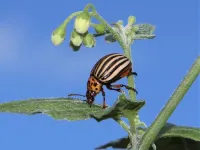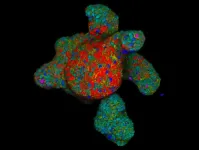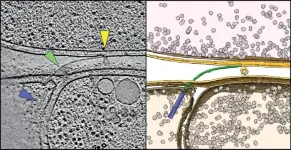(Press-News.org) The biosynthetic pathway of specific steroidal compounds in nightshade plants (such as potatoes, tomatoes and eggplants) starts with cholesterol. Several studies have investigated the enzymes involved in the formation of steroidal glycoalkaloids. Although the genes responsible for producing the scaffolds of steroidal specialized metabolites are known, successfully reconstituting of these compounds in other plants has not yet been achieved. The project group ‘Specialized Steroid Metabolism in Plants’ in the Department of Natural Product Biosynthesis, led by Prashant Sonawane, who is now Assistant Professor at the University of Missouri in the USA, set out to find the missing piece of the puzzle. “With our research project, we particularly wanted to clarify which important component of the biosynthesis pathway has so far remained hidden from research and what role this gene or protein plays in the pathway. We also wanted to find out whether we could reconstitute the biosynthetic pathway after identifying the missing component. An important aspect of our study was also to find out more about the ecological role of steroidal saponins in plants,” says Prashant Sonawane, describing the questions of the study.
GAME15 - an unknown but crucial player in the biosynthesis of steroidal molecules in Solanum
The research team used the wild plant Solanum nigrum (black nightshade) for the studies because it produces different steroidal compounds in different tissues, all of which are derived from the same precursor, cholesterol. In the leaves, the most important steroidal metabolite is a saponin called uttroside B, while in the berries the most important compounds are steroidal glycoalkaloids such as α-solasonine, α-solamargine and malonyl-solamargine. The enzymes GAME6, GAME8 and GAME11 are involved in the formation of both types of compounds and are found in both leaves and berries. Confocal microscopy was used to determine where these enzymes are located in the cells. Through biochemical and molecular biological analyses, the researchers identified a gene responsible for a protein called GAME15. Although GAME15 belongs to the family of cellulose synthase-like proteins, it has no function in cellulose production. Instead, it is important for the biosynthesis of steroidal compounds, even though it does not have a catalytic function like other enzymes.
“Our protein interaction experiments showed that GAME15 interacts with the enzymes GAME6, GAME8 and GAME11. These enzymes are responsible for the first steps in the hydroxylation of cholesterol, leading to the formation of the furostanol-aglycone (16,22,26-trihydroxycholesterol), a key branching point between the synthesis of steroidal saponins and glycoalkaloids. Using Solanum nigrum plants in which the GAME15 gene was knocked out, we were able to show that these plants were no longer able to produce steroidal glycoalkaloids and saponins,' explains first author Marianna Boccia, one of the main findings of the study.
Steroidal compounds from Solanum have great potential for medical applications
Steroidal saponins and steroidal glycoalkaloids are groups of compounds with promising medical applications. For example, recent studies show that certain saponins are highly effective in treating liver cancer. Steroidal glycoalkaloids also have anti-cancer properties, as well as antimicrobial and anti-inflammatory activities. "By identifying GAME15, we were able to reconstitute the metabolic pathway for steroidal compounds in heterologous hosts such as Nicotiana benthamiana, up to the scaffold furostanol, a precursor of steroidal saponins, and solasodine, an immediate precursor of steroidal glycoalkaloids," says Prashant Sonawane. Reconstituting medically interesting compounds in plants such as Nicotiana benthamiana is also known as 'pharming', a portmanteau of 'pharmaceutics' and 'farming'. Pharming involves the use of genetically modified plants with an integrated biosynthetic pathway for the production of medical compounds to produce drugs cost-effectively and on a large scale. The results of the study therefore open up possibilities for improved production of important steroid-based compounds.
First evidence of the ecological role of saponins in the defense against herbivores
Steroidal glycoalkaloids are already known to be important plant defense substances. They are toxic compounds typical of solanaceous plants and are also found in potatoes, tomatoes and eggplants. However, their toxicity can be significantly reduced in crops by peeling, cooking or frying. In tomatoes, the glycoalkaloids are broken down during ripening, so they are barely detectable in the red fruit. However, the ecological role of steroidal saponins in Solanum nigrum leaves was so far unknown. A key clue came from the greenhouse team, who noticed that GAME15 knockout plants, which are unable to produce saponins, were more susceptible to insect herbivores than wild-type plants. Intrigued by this observation, the researchers carried out ecological experiments in the form of feeding trials with two natural Solanum pests. "In a first experiment, two herbivores, the leafhopper Empoasca decipiens and the Colorado potato beetle Leptinotarsa decemlineata, were given a choice between leaves of wild-type plants (which produce steroidal saponins) and leaves of Game15 knockout plants (which do not produce saponins due to the knockout of the GAME15 gene). After a week, we measured the damage caused by the insects. The results clearly showed that both herbivore species fed almost exclusively on the knockout leaves, showing a preference for them over the wild-type leaves. In a second experiment, we use a "forced-feeding” bioassay, specifically with Colorado potato beetles. In this test, we placed individual beetles with detached leaves from either wild-type or knockout plants. After just six hours, the beetles readily fed on the knockout leaves lacking steroidal saponins, while they largely avoided the wild-type leaves, apparently preferring to starve rather than feed," says Marianna Boccia, describing the first evidence for the role of steroidal saponins in plant defense. One possible explanation for the different groups of compounds in leaves and berries is that these compounds are specialized to protect different plant tissues. Leaves are more likely to be attacked by herbivores, while berries are more susceptible to pathogens.
“Our discoveries highlight how Solanaceae plants have adapted a cellulose-synthase like protein hijacked from a core metabolism role (such as cellulose biosynthesis) to a structural role, required for the biosynthesis of compounds specialized in the defense of the plants against pathogens. This discovery opens up new opportunities for engineering crops with enhanced resistance to pests and for the production of important steroid-based compounds to fight cancer and other diseases,” says Sarah O'Connor, Director of the Department of Natural Product Biosynthesis and a senior author of the study.
END
Key protein for the biosynthesis of defense steroids in solanaceous plants discovered
Max Planck researchers identify the crucial protein for controlling the biosynthesis of steroidal glycoalkaloids and saponins in plants of the genus Solanum and for the first time demonstrate the ecological role of steroidal saponins in insect defense
2024-10-17
ELSE PRESS RELEASES FROM THIS DATE:
Global CO2 emissions from forest fires increase by 60%
2024-10-17
A major new study reveals that carbon dioxide (CO2) emissions from forest fires have surged by 60% globally since 2001, and almost tripled in some of the most climate-sensitive northern boreal forests.
The study, led by the University of East Anglia (UEA) and published today in Science, grouped areas of the world into ‘pyromes’ - regions where forest fire patterns are affected by similar environmental, human, and climatic controls - revealing the key factors driving recent increases in forest fire activity.
It is one of the first studies to look globally at the differences between forest ...
AI-assisted deliberation can help people with different views find common ground
2024-10-17
A new study shows that an artificial intelligence (AI) tool can help people with different views find common ground by more effectively summarizing the collective opinion of the group than humans. By producing statements that convey the majority opinion, while incorporating the minority’s perspective, the AI produced outputs that participants preferred—and that they rated as more informative, clear, and unbiased, compared to those written by human mediators. Human society is enriched by a plurality of viewpoints, but agreement is a prerequisite for people to act collectively. ...
Special Issue explores factors influencing democratic attitudes, and what’s at stake for science in the U.S. after November election
2024-10-17
The health of American democracy is facing challenges, with experts pointing to recent democratic backsliding, deepening partisan divisions, and growing anti-democratic attitudes and rhetoric. In this issue of Science, Research Articles, a Policy Forum, a Science News feature, and a related Editorial highlight how the tools of science and technology are being used to address this growing concern and how the upcoming U.S. presidential election could impact U.S. science.
In one research study in this special issue, Jonathan Chu and colleagues sought to understand whether understandings ...
Extratropical forest fire emissions are increasing as climate changes
2024-10-17
As climate change promotes fire-favorable weather, climate-driven wildfires in extratropical forests have overtaken tropical forests as the leading source of global fire emissions, researchers report. The findings raise urgent concerns about the future of forest carbon sinks under climate change. Fire has long played a role in shaping Earth's forests and regulating carbon storage in ecosystems. However, anthropogenic climate change has intensified fire-prone weather, leading to an increase in burned areas and carbon emissions, particularly in forested regions. These fires not only reduce forests' ability to absorb carbon but also disrupt ecosystems, harm biodiversity, and pose significant ...
A new approach to capturing complex mixtures of organic chemicals in blood, evaluated in pregnant women
2024-10-17
Studies of chemicals in our blood typically capture only a small and unknown fraction of the entire chemical universe. Now, a new approach aims to change that. In a study involving blood samples of pregnant women collected between 2006 and 2008, researchers report having quantified many complex mixtures of chemicals that may pose neurotoxic risks, even when the individual chemicals were present at seemingly harmless levels. “The quantification of 294 to 473 chemicals in plasma is a major improvement compared with the usual targeted analysis focusing on only few selective analytes,” wrote the authors. ...
Gut instincts: Intestinal nutrient sensors
2024-10-17
A multi-institutional group of researchers led by the Hubrecht Institute and Roche’s Institute of Human Biology has developed strategies to identify regulators of intestinal hormone secretion. In response to incoming food, these hormones are secreted by rare hormone producing cells in the gut and play key roles in managing digestion and appetite. The team has developed new tools to identify potential ‘nutrient sensors’ on these hormone producing cells and study their function. This could result in new strategies to interfere with the release of these hormones and provide avenues for the treatment of a variety of metabolic or gut motility disorders. The work will be presented ...
Catching prey with grappling hooks and cannons
2024-10-17
Countless bacteria call the vastness of the oceans home, and they all face the same problem: the nutrients they need to grow and multiply are scarce and unevenly distributed in the waters around them. In some spots they are present in abundance, but in many places they are sorely lacking. This has led a few bacteria to develop into efficient hunters to tap into new sources of sustenance in the form of other microorganisms.
Although this strategy is very successful, researchers have so far found only a few predatory bacterial species. One is the soil bacterium Myxococcus xanthus; ...
Effects of chemical mixtures: Neurotoxic effects add up
2024-10-17
"In our everyday lives, we are exposed to a wide variety of chemicals that are distributed and accumulate in our bodies. These are highly complex mixtures that can affect bodily functions and our health," says Prof Beate Escher, Head of the UFZ Department of Cell Toxicology and Professor at the University of Tübingen. "It is known from environmental and water studies that the effects of chemicals add up when they occur in low concentrations in complex mixtures. Whether this is also the case in the human body has not yet been sufficiently investigated - this is precisely where our study comes in."
The extensive research work was based on over 600 blood samples from ...
Mpox in Africa was neglected during the previous outbreak, and requires urgent action and investment by leaders now to prevent global spread
2024-10-17
Mpox in Africa was neglected during the previous outbreak, and requires urgent action and investment by leaders now to prevent global spread, claim experts from The Independent Panel for Pandemic Preparedness and Response, ex-NZ Prime Minister Helen Clark, former Liberian President and Nobel Peace Prize winner Ellen Johnson Sirleaf, and other global health specialists.
####
Article URL: https://journals.plos.org/globalpublichealth/article?id=10.1371/journal.pgph.0003714
Article Title: Mpox: Neglect has led to a more dangerous virus now spreading across borders, harming and killing people. Leaders must take action to stop mpox now
Author Countries: ...
A new era of treating neurological diseases at the blood-brain-immune interface
2024-10-17
SAN FRANCISCO—The question of what causes complex neurological diseases such as Alzheimer’s or multiple sclerosis continues to confound scientists and doctors, with the unknowns standing in the way of early diagnoses and effective treatments.
Even among identical twins who share the same genetic risk factors, one may develop a particular neurological disease while the other does not.
That’s because unlike diseases such as cystic fibrosis or sickle-cell anemia, which are caused by a single gene, most neurological disorders are associated with many—sometimes hundreds—of rare genetic variants. ...
LAST 30 PRESS RELEASES:
UCLA study links scar healing to dangerous placenta condition
CHANGE-seq-BE finds off-target changes in the genome from base editors
The Journal of Nuclear Medicine Ahead-of-Print Tip Sheet: January 2, 2026
Delayed or absent first dose of measles, mumps, and rubella vaccination
Trends in US preterm birth rates by household income and race and ethnicity
Study identifies potential biomarker linked to progression and brain inflammation in multiple sclerosis
Many mothers in Norway do not show up for postnatal check-ups
Researchers want to find out why quick clay is so unstable
Superradiant spins show teamwork at the quantum scale
Cleveland Clinic Research links tumor bacteria to immunotherapy resistance in head and neck cancer
First Editorial of 2026: Resisting AI slop
Joint ground- and space-based observations reveal Saturn-mass rogue planet
Inheritable genetic variant offers protection against blood cancer risk and progression
Pigs settled Pacific islands alongside early human voyagers
A Coral reef’s daily pulse reshapes microbes in surrounding waters
EAST Tokamak experiments exceed plasma density limit, offering new approach to fusion ignition
Groundbreaking discovery reveals Africa’s oldest cremation pyre and complex ritual practices
First breathing ‘lung-on-chip’ developed using genetically identical cells
How people moved pigs across the Pacific
Interaction of climate change and human activity and its impact on plant diversity in Qinghai-Tibet plateau
From addressing uncertainty to national strategy: an interpretation of Professor Lim Siong Guan’s views
Clinical trials on AI language model use in digestive healthcare
Scientists improve robotic visual–inertial trajectory localization accuracy using cross-modal interaction and selection techniques
Correlation between cancer cachexia and immune-related adverse events in HCC
Human adipose tissue: a new source for functional organoids
Metro lines double as freight highways during off-peak hours, Beijing study shows
Biomedical functions and applications of nanomaterials in tumor diagnosis and treatment: perspectives from ophthalmic oncology
3D imaging unveils how passivation improves perovskite solar cell performance
Enriching framework Al sites in 8-membered rings of Cu-SSZ-39 zeolite to enhance low-temperature ammonia selective catalytic reduction performance
AI-powered RNA drug development: a new frontier in therapeutics
[Press-News.org] Key protein for the biosynthesis of defense steroids in solanaceous plants discoveredMax Planck researchers identify the crucial protein for controlling the biosynthesis of steroidal glycoalkaloids and saponins in plants of the genus Solanum and for the first time demonstrate the ecological role of steroidal saponins in insect defense





